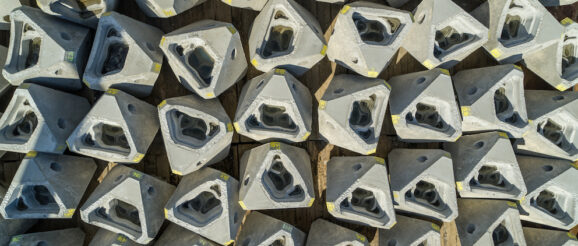San Diego pilots sea-life boosting alternative to conventional tidal defences – Innovation – GCR

The Port of San Diego has begun installing a unique type of sea wall to protect the edges of Harbor Island, a man-made peninsula in San Diego Bay, in the hope of restoring its marine ecosystem in a way conventional sea defences do not.
The Coastalock system, developed by Israel-based company Econcrete, comprises interlocking hollow units made of proprietary bio-enhancing concrete that provide habitats for oysters, starfish, algae, grasses, echinoderms and other marine wildlife – which can fail to thrive in the barren environments created by rubble or concrete modules, known as riprap.
In a three-year pilot, the port will replace riprap with 72 of the 3.5-tonne modules in two locations to see if it regenerates the local ecosystem by creating a series of rich, interlocking tidal pools.
Econcrete said it is the first of several large-scale installations around the world of Coastalock, which was selected by Time Magazine as one of the 100 best inventions in 2019.
The pilot is part of the Port’s Blue Economy Incubator scheme, which is promoting sustainable aquaculture and ocean-oriented – termed “Blue Economy” – technology ventures.
Every six months, Econcrete will evaluate the viability of the tide pool units as an ecological armouring replacement to traditional riprap.
How it works
Econcrete was founded in 2012 by marine ecologists Dr. Shimrit Perkol-Finkel and Dr. Ido Sella to meet growing demand for ecological enhancement.
In a three-year pilot, the port will replace riprap with 72 of the 3.5-tonne modules in two locations to see if it regenerates the local ecosystem by creating a series of rich, interlocking tidal pools (Courtesy of Econcrete)
They say Coastalock units interlock along eight planes, enabling life-enhancing structural variation.
The idea is that, when installed, oysters, tube worms and coralline algae move into the niches to build up a layer of calcium carbonate, adding weight and stability to the system while buffering hydrodynamic focus and chlorides.
Rough surface textures facilitate organisms’ ability to attach and form a community, while the concrete’s admix promotes biocalcification and CO2-consuming photosynthesis.
The admix is made of greater-than 90% recycled and byproduct materials, which cuts it’s carbon footprint.
Concrete benefits
“By mimicking natural rock pools with beautiful water retaining features, the project will sustain valuable marine life while coping with climate change and urbanisation,” said Rafael Castellanos, commissioner and environmental advisory board chair at the Port of San Diego Board of Port Commissioners.
“Harbor Island is the first and only location in Southern California for locals and visitors to see first-hand what kind of sea life takes residence in man-made tide pools.”
Dr. Shimrit Perkol-Finkel, co-founder and chief executive of Econcrete, said: “This Blue Economy pilot is proving that the coastal and marine construction industry can achieve two goals at once: any concrete infrastructure going into the water can perform structurally and be good for ecosystems.”
Top image: Oysters, tube worms and coralline algae move into the niches to build up a layer of calcium carbonate (Courtesy of Econcrete)
